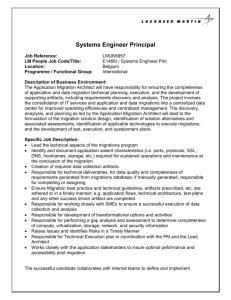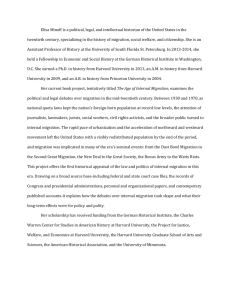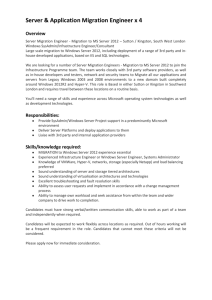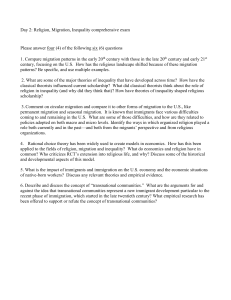NEH Stories of Migration, Janet Morford
advertisement
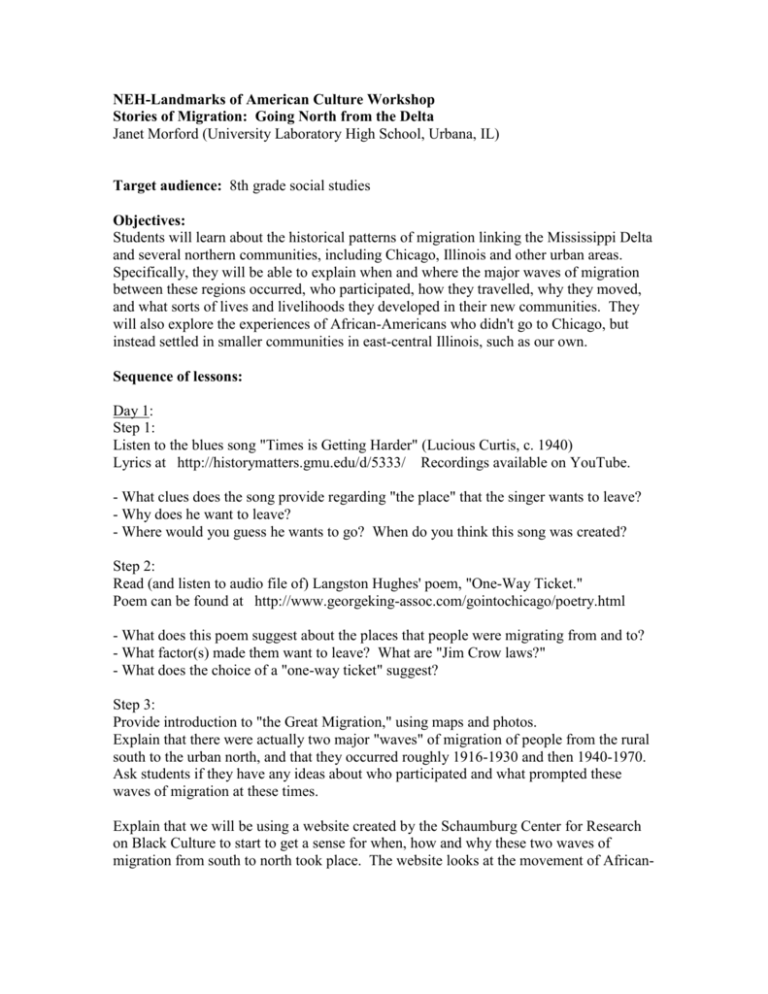
NEH-Landmarks of American Culture Workshop Stories of Migration: Going North from the Delta Janet Morford (University Laboratory High School, Urbana, IL) Target audience: 8th grade social studies Objectives: Students will learn about the historical patterns of migration linking the Mississippi Delta and several northern communities, including Chicago, Illinois and other urban areas. Specifically, they will be able to explain when and where the major waves of migration between these regions occurred, who participated, how they travelled, why they moved, and what sorts of lives and livelihoods they developed in their new communities. They will also explore the experiences of African-Americans who didn't go to Chicago, but instead settled in smaller communities in east-central Illinois, such as our own. Sequence of lessons: Day 1: Step 1: Listen to the blues song "Times is Getting Harder" (Lucious Curtis, c. 1940) Lyrics at http://historymatters.gmu.edu/d/5333/ Recordings available on YouTube. - What clues does the song provide regarding "the place" that the singer wants to leave? - Why does he want to leave? - Where would you guess he wants to go? When do you think this song was created? Step 2: Read (and listen to audio file of) Langston Hughes' poem, "One-Way Ticket." Poem can be found at http://www.georgeking-assoc.com/gointochicago/poetry.html - What does this poem suggest about the places that people were migrating from and to? - What factor(s) made them want to leave? What are "Jim Crow laws?" - What does the choice of a "one-way ticket" suggest? Step 3: Provide introduction to "the Great Migration," using maps and photos. Explain that there were actually two major "waves" of migration of people from the rural south to the urban north, and that they occurred roughly 1916-1930 and then 1940-1970. Ask students if they have any ideas about who participated and what prompted these waves of migration at these times. Explain that we will be using a website created by the Schaumburg Center for Research on Black Culture to start to get a sense for when, how and why these two waves of migration from south to north took place. The website looks at the movement of African- Americans over a much wider historical period and it has some unique features, so it may be useful to take a few minutes to orient students to the website's organization in class. http://www.inmotionaame.org/migrations/ Homework: - Read about the Great Migration (1916-1930), on the "In Motion" website from the Schaumburg Center, with particular attention to the sections entitled: "Overview," "Leaving the South," "Migration Fever" http://www.inmotionaame.org/migrations/landing.cfm?migration=8 - Students are assigned to pay special attention to one of these three points, taking notes on a handout provided: - the parameters of this migration wave (how many people, why at this time) - "push factors" (reasons people wanted to leave the south) - "pull factors" (incentives to go to northern cities) Day 2: Step 1: - Look for clues about the experiences of migrants in a painting from Jacob Lawrence's series on the Great Migration (see the Phillips Collection website). Discuss key images or themes. Or use one of the maps on the Schaumburg Center website as a point of focus. Step 2: - Break students into groups based on assigned homework focus. Students review what they found. Each group has one big sheet or one section of the board to draw or write a few key words about their topic, before they present to the class. Following guidelines provided, they must decide who will speak, who will draw and who will be digital recorder(s) for their group. Step 3: - Each group presents in turn. Students from other groups take notes on their handouts. Digital recorders save and send their notes to teacher, for complete document that can later be posted or shared with whole class. Step 4/Homework: - Preview remaining aspects of the first "Great Migration" to be explored via same website: - Getting there - Working - Living in the north Give each group of students its assignment and handout for note-taking. Day 3: - Repeat the drawing/speaking/note-taking process outlined above, but have students take on a new role within their group. Use records from previous day to clarify trouble spots. - Homework: Make sure notes on first "Great Migration" are complete, legible and ready to turn in. Days 4 - 5: - Students read key segments of "In Motion" website, on The Second Great Migration (1940 - 1970). http://www.inmotionaame.org/migrations/landing.cfm?migration=9 - Students work in pairs to complete a chart that shows the contrasts between these two waves of migration, looking at the same criteria explored with respect to first wave. Days 6 - 7: - View documentary film, "Goin' to Chicago" (1994), 71 mn, in three segments. This film focuses mostly on the experiences of African-Americans who were born in Mississippi, but migrated to Chicago during the Second Great Migration, and in the early 1990s, are returning to Greenville, Mississippi for a "homecoming." Before viewing, provide students with a map that shows the different places discussed in the film. - Have students read relevant parts of the film website, such as the interview with the film's director and producer, and brief biographies of the individuals featured in the film. http://www.georgeking-assoc.com/gointochicago/index.html - Have students write short reviews of the film, including reflections on the creation and use of "simulated newsreels" to convey some of the background information. Days 8 - 9: - Look at maps that demonstrate the development of means of transportation connecting the Mississippi Delta with different communities in Illinois (Illinois Central railroad, highways, Greyhound bus lines, etc.). Have students consider factors that could have led migrants from Mississippi to settle in Champaign County, rather than going to Chicago. - Review and discuss sources that address the settlement and experiences of AfricanAmericans in Champaign County, such as historical overviews, oral history interviews, newspaper articles, census data, etc. What do these sources indicate about how the experience of living in small or medium-sized towns may have been different? In what ways did racial segregation in schools, residential patterns and public places in local Illinois communities during much of the 20th century continue to put African-Americans at a disadvantage? What organizations or networks at the local level were important sources of support for African-Americans? Days 10 - 12: Students, working alone or in pairs, prepare one of these cumulative assessments: - Plan a storyboard for a short documentary film that traces the experiences of AfricanAmericans from Mississippi who settled in east-central Illinois during the first or second "Great Migrations." You may use historical photos and/or artwork (such as the series of paintings by Jacob Lawrence) to illustrate various scenes. Consider what kind of music you'd like to use in the soundtrack. - Write a script for a short radio piece that incorporates segments from an oral history interview done with members of a local African-American family, who came to Champaign County during the first or second "Great Migration." Be sure to include music that sets the tone both at the beginning and the end of your narrative. - Create an illustrated timeline of the first and second "Great Migrations" that highlights important milestones and identifies key "push" and "pull" factors involved in each wave. You may use charts, maps, photos, artwork and other graphics to illustrate and expand upon the information given in relation to specific milestones.



